When railroads first arrived in Arizona, they quickly established themselves as one of the primary factors driving economic and population grown while the region was still a territory. The fact that Arizona was still a territory and lived up to the wild-west atmosphere actually helped/influenced the rail industry into building a rail infrastructure.
Territorial Reasons (1864-1912)
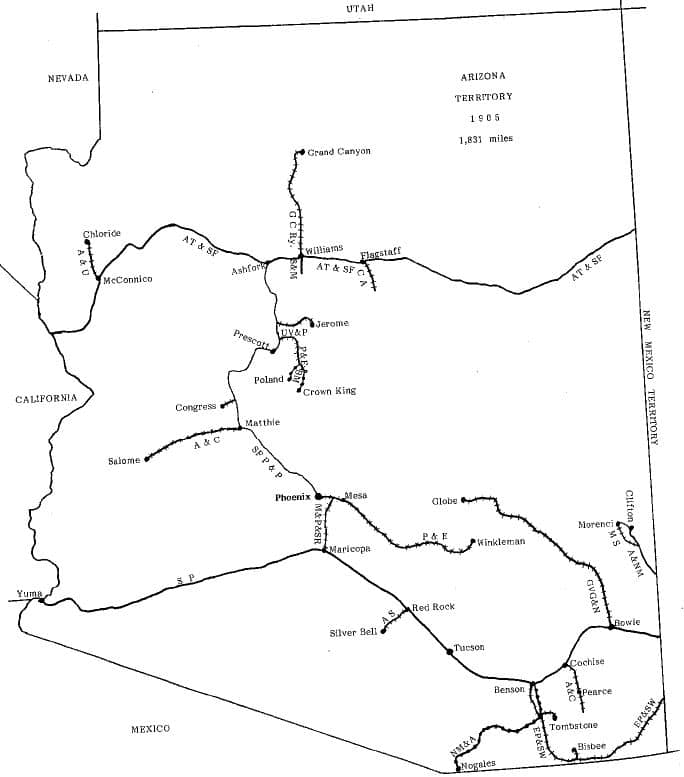
The population of the territory as of 1870 was a meager 9,658 people, when compared to states like New York (942,292) and the overall population of 32 million, it was clear that an easier method of delivering the population to the territory was needed. The majority of the 9,658 people in the territory were concentrated in towns such as Tucson, Prescott, Yuma, and mining camps all of which had great distances between them. Having a rail infrastructure in the state even led many to believe the Apache raids, and Stagecoach robberies which had plagued the territory would decrease with the arrival of the modern world.
With such a small population at the time, and a territorial area of 144,000 mi2, Transportation problems soon reared their head. The environment/landscape itself worked against the population, with vast swaths of desert, mountains, a lack of water or animals for food made trekking across the territory no ordinary walk in the park. While there were local and army wagon roads in the area, none of which could serve as an artery for long distance travel. The Native population did have well established cattle trails which formed over time, however the over whelming majority ran North-South, rather than East-West. If the transportation itself was not difficult enough, the cost for a 16-29 hour trip across the territory ran at $20-$30 at the time ($375-$575 today).
The mining industry played a large role in bringing the locomotive industry to Arizona as well. In 1854 the Arizona Mining & Trading company opened its doors in Ajo, just a decade later a quarter of the non-native male population were prospectors for copper, silver, and gold. By 1912 the industry had grown exponentially, totaling 445 mines, 72 concentrating facilities, 11 smelters, churning out a profit of $67 million.
Mining alone was not the only industry that would help seduce the Rail companies into breaking ground in the territory, the cattle industry would lend a helping hand as well. In 1877 congress passed the Desert Land Act, whose goal was to stimulate population growth by incentivizing citizens to move/settle in the west. Unlike the mining industry, trains would help initially bring cattle to the area, as well as stimulating its growth as time passed. In 1880, there were a total of 135,757 head of cattle in the territory, by 1890 that number grew to nearly 1 million (927,880) thanks in large part to the rail industry.
Trains would begin to arrive thanks in large part to the Gadsden Purchase in 1853, which would lay the groundwork of statehood. Jefferson Davis, and James Gadsden negotiated the purchase of the 29,000 acres for $10 million, for the future purpose of developing a transcontinental rail road. Plans for a federally sponsored rail line would eventually encounter delays thanks to the Kansas-Nebraska Act followed by the Civil War. However, the land was now federally owned and could be used for future routes.
Southern Pacific Line (1877-Present)
‘The Big Four’, Collis P Huntington, Charles Crocker, Mark Hopkins, and Leland Stanford are largely responsbile for constructing what would become the Southern Pacific Line as well as the Central Pacific Rail Road itself. The Southern Pacific line was originally intended to run out of Marshall, Texas to San Diego, California by the Texas and Pacific Railway, but encountered delays due to the panic of 1873.
Southern Pacific then took over the primary responsibility of constructing the line itself, starting in CA and heading east. Out of California the rail line would mirror the 32nd parallel to Yuma. The city was chosen due to a few attractive features the area boasted. Fort Yuma was already there having been erected in 1850, in addition to being located on the Colorado River. In 1877 construction hit a snag once again, as a fight between northern and southern representatives broke out. Arguments over whether the route should be built in the north or the south of the territory. After three failed sessions, an agreement was eventually reached with a 15-3 vote. Yuma would be selected as the first site for building the line including a key bridge over the Colorado River, while a northern route was selected as well.
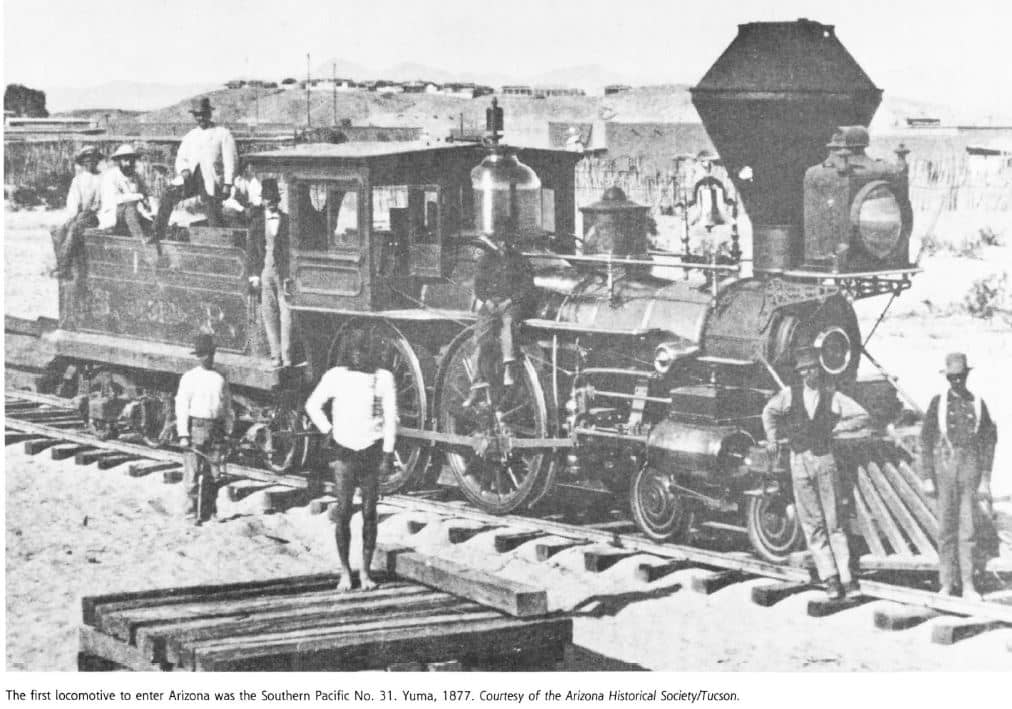
The Southern Pacific line would eventually span a total of 384.25 miles, largely built on the back of Chinese labor as well as Steam delivered supplies via the Colorado river. The bridge which needed to be built in Yuma would end up being quite the challenge due to many different factors. At the time, both Southern Pacific and the Texas & Pacific Railways were given permission to build the line. This made George W. McCrary, the Sec. of War at the time uncomfortable, so naturally he revoked permission from both companies. In addition, Major Dunn of Fort Yuma had a few stipulations when it came to constructing the bride over the river. He initially would allow construction of the North Pier, but forbid construction of the crucial draw span of the bridge. While the bridge would be completed on September 29, 1877 it lacked the all-important rails. In a determination to complete their work, Railroaders snuck onto the bridge at midnight to lay the rails, and with only four soldiers guarding the bridge they could not stop construction. The following day, September 30th 1877 saw the arrival of the first train, although full operational capabilities did not come until 1878. Rates went at $.10 per mile for passengers, and $.15 for one ton of freight. The total cost of the line was $31,764,115 (roughly $750 million accounting for inflation)
Atlantic & Pacific/Atchison, Topeka, and Santa Fe (1880-Present)
The northern route through the Territory, which was the cause of much headache while building the Southern Pacific line, would be a part of the Atlantic-Pacific line. Born out of Andrew Johnsons 1866 bill chartering a railroad to California, the A/P line was primarily for the northern cattle industry. The line would begin in Missouri, run through Arizona, and end in San Francisco. While Atlantic & Pacific had started the construction, during the panic of 1873 allowed Atchison, Topeka, and Santa Fe to purchase the rights to the railroad. By the time they received the rights to build in 1875, only 361 miles of track had been built. Thankfully ATSF was given A&P’s federal land grants/loans as well as partnering with the St Louis, and San Francisco rail lines to get the ball rolling. This agreement between parties would become known as the Tripartite Agreement.
Construction would begin to move at a blistering pace, averaging over a mile of track laid per day. The burden of maintaining this breakneck pace fell mostly to the Native American, Mexican, and Mormon labor that was used. The towns of Kingman, Drake, Holbrook, Winslow are all named after men who worked this line. Meanwhile, the Southern Pacific Railway saw the ATSF line as an immediate threat, so in a move of corporate pettiness, they built a branch from Mojave to Needles to cut off the Santa Fe line. Cooler heads would prevail and S&P would exchange the Mojave-Needles route with ATSF in exchange for a rail line that ran through the Guaymas.
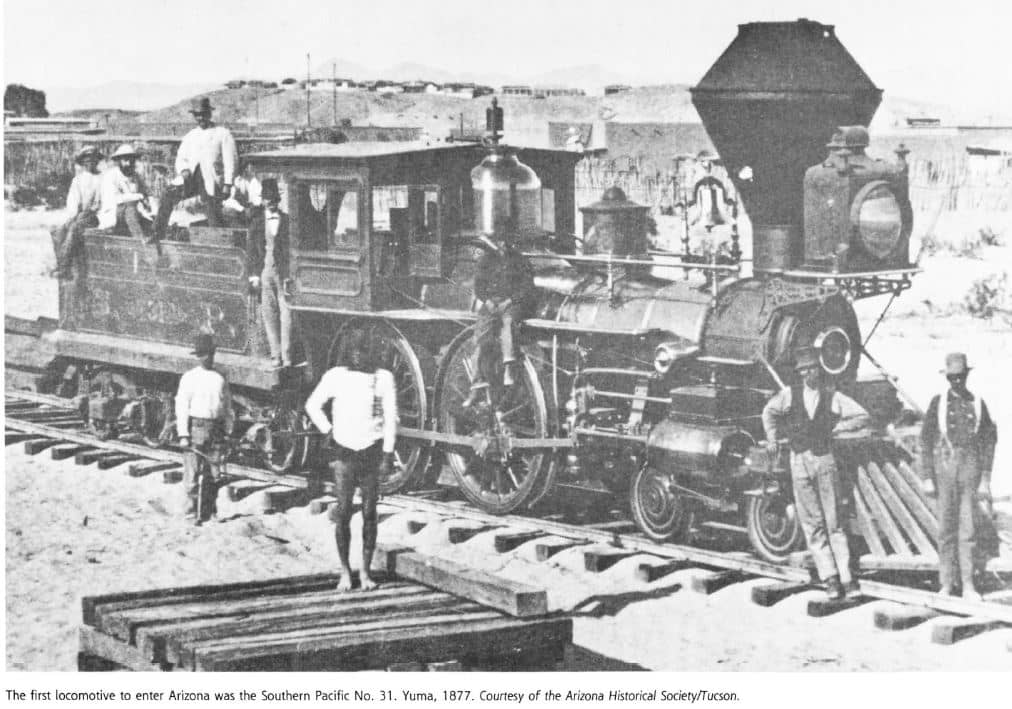
If it wasn’t corporate animosity causing setbacks, the ATSF line encountered resistance from the geography too. Enter, Canyon Diablo, spanning 550 feet across, and 225 feet deep. At the time of construction, the railroad front was still 100 miles away, meaning all supplies and water had to be hauled for that distance. Summer rain, and biting cold winters slowed progress considerably. In the end it would take 240 men, a 6 month delay, and $250,000 to complete the bridge.
Finally, in 1882 the Rail line would arrive in Flagstaff, the town which, was settled exclusively because of the Railroad. It began with merchants who wanted to take advantage of the railroad and the opportunities it would bring settles a small town. At first it was known as Observatory Mesa, or Mars Hill before eventually becoming Flagstaff. It would become the largest town on the line between Albuquerque and the west coast. In 1902, ATSF was consolidated with holdings which remained from Atlantic & Pacific creating the Atchison, Topeka, and Santa Fe Railway.
New Mexico and Arizona Railroad (1882-1960)
This line was technically a branch off of the Southern Pacific Railway, it ran from Benson to Nogales connecting to a Mexican Rail line that ran from Guaymas and the Gulf of California. It also served the cattle industry of the south, which averaged 3000 head a day on the line. In addition, the railway was utilized in order to ship ore to the smelters. The line had strategic/tactical value for the US military as well, the NM & AZ line was heavily used during the campaign against Geronimo transporting Federal troops to the area. Unfortunately by 1960, natural and continual flooding caused the deterioration of the track, leading it to be disassembled piece by piece until it was no more.
Prescott & Arizona Central Railway/Santa Fe, Prescott, and Phoenix (1886-Present)
Tom Bullock, who first bartended on Prescott’s Whiskey Row before moving to New York where he would make a fortune selling street railcars, was the first person/driving force for suggesting and eventually building the Prescott & Arizona Central Railway. He organized a group of investors known as the New York Syndicate, with the plain to build a narrow gauge line (to save money) to Jerome for the rich copper mines found there.
At the same time, another bustling entrepreneur by the name of Frank Murphy formed his own syndicate with similar goals as Bullock. However, Murphy’s group wanted a Standard gauge line running to Phoenix, as they did not think the narrow gauge Jerome line would garner enough traffic.
Eventually on May 10th 1885 the Arizona Central Railway Company gathered in Prescott, marking the start of what would become known as the ‘Battle of Prescott’. Bullock would emerge the victor, although he gave two major concessions to Murphy’s group. The line would be built with standard gauges, and when the line expanded to phoenix it would follow the Hassyampa River route through Congress. The company wanted the Railway built, but they wanted the citizenry behind the project as well, offering to throw their support behind Bullock if he could secure it. Citizens of Prescott eventually raised $300,000 for the rail line, with the stipulation that it be completed by 12/31/1886 or face a $1000 penalty per mile. The line would be completed with just five minutes to spare on the last day! The hasty construction however led to a very poor quality rail line, and problems ensued shortly after completion.
Finally, in 1891 ‘A Bill to Encourage the Construction of Railroads within the Territory of Arizona’ was passed providing tax emptions to companies. This led to the creation of the Santa Fe, Prescott, and Phoenix Railway who would buy out the Phoenix & Arizona Railway. This new company was headed by Frank Murphy, who eventually expanded the line to Phoenix in 1895.
United Verde and Pacific Railway (1894-1920)
This Railway came to being as a way to link the booming copper town of Jerome, to the larger Santa Fe line in Prescott. The effort was spearheaded by Senator William Clark of Montana. The line would be a total of 26 miles long, built on narrow gauge line due to the terrain, as well as the man-made grade of 3% and severe curvature of the turns (the max curviture on the line was 24 Degrees). Due to these various phsyical characteristics it became known as the most crooked rail line in the world, before being abandoned in 1920.
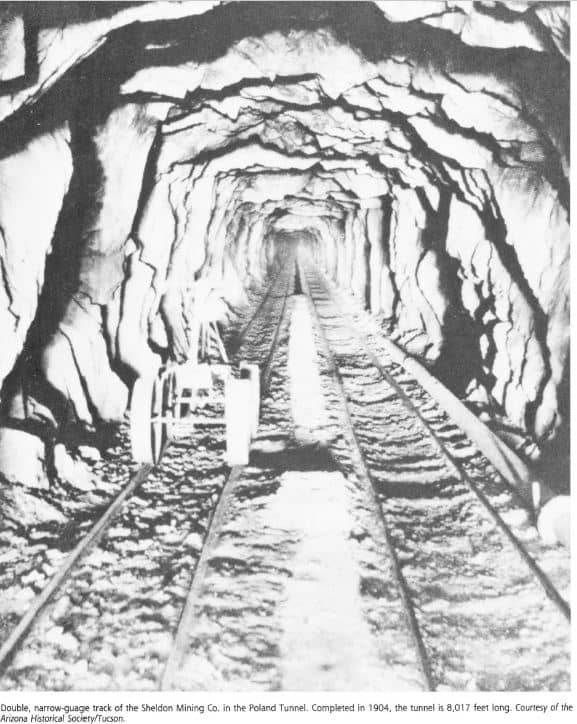
Bradshaw Mountain Railway (1901-Present)
Known as the “Impossible” Railroad, the Bradshaw Mountains were chock full of Silver and Gold, but were extremely steep in their terrain and dangerous. Frank Murphy (The same gentleman from the Sante Fe, Prescott and Phoenix Railway) owned several mining operations in the area, and took it upon himself to lead the charge for the construction of this line.
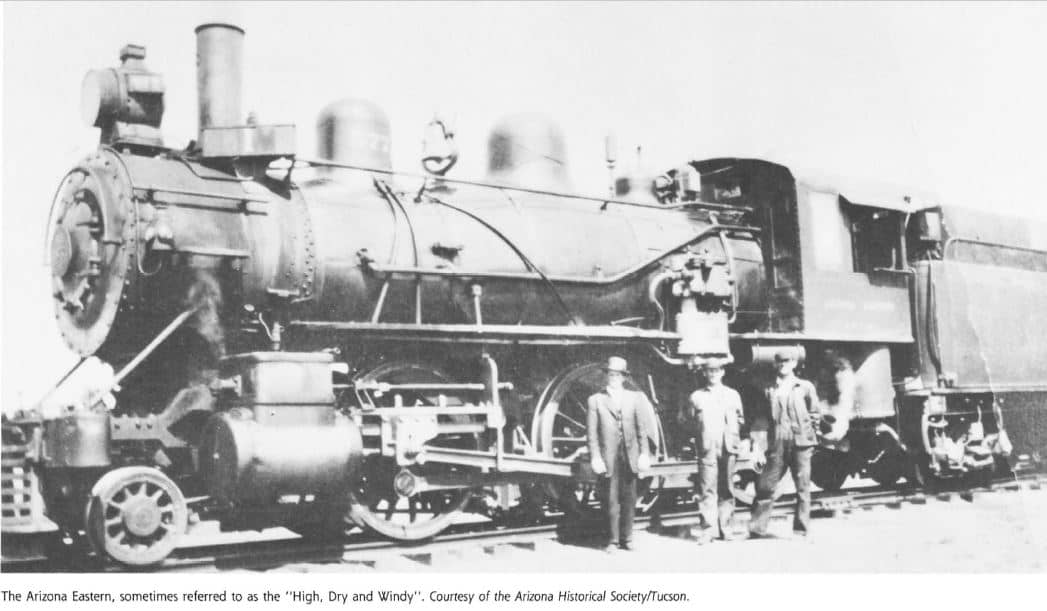
Construction unsurprisngly encountered setbacks due to the hazardous terrain along the way. Murphy went on to hire a crew, paying them $1 a day (twice the average rate at the time) however even lucrative pay could not stop a large percentage of the crew abandoning the project after casualties which stemmed from a dynamite blast on a exposed vein of gold. But with the mines putting out $400,000 annually in gold and silver, construction would continue.
In 1902, the first line was completed, and $180,000 worth of ore was hauled out in the first week. Not one to shy away from success, Frank then began construction on the Crown King line from Mayer to Cordes. A 13 mile track 6000 feet up, a track which had so many switchbacks it took seven miles of tracks to physically travel two miles.
















